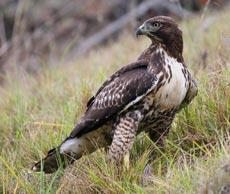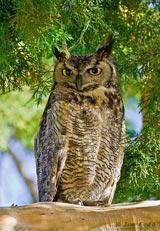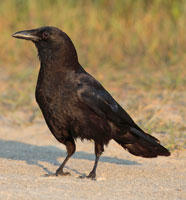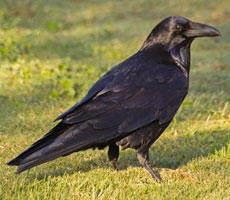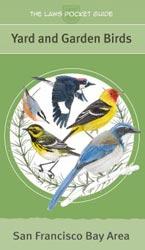Top 30 Backyard Birds
Part I Part II Part III Part IV Part V Part VI
|
|
For our final set of birds, we're pushing a bit beyond the typical feeder birds to include some of our most notable bigger birds. Larger in size than our preceding entries, these birds generally have larger territories and will spend proportionately less of their lives within the strict confines of your backyard, but all are abundant species you can find around your neighborhood or soaring above it in blatant disregard of our demarcated property lines. Some of them get along less well than others with the small songbirds that visit one's feeders, though there are often specific steps you can take to reduce conflicts. And in the big picture, the best approach, as always, is an open-minded appreciation of the full spectrum of our native birds.
26. Cooper's Hawk
|
|
Identifying: This is the most likely hawk to see in your yard, with their preferred foods being birds in the starling to mourning dove size range, though they will sometimes catch smaller feeder birds. (In the winter, you may also see their slightly smaller look-alike, the Sharp-shinned Hawk, who eats more small songbirds like sparrows and finches—see this page to delve into the details.) In fact, if you see it pursuing your yard birds, you can more or less rule out most birds other than Cooper's and Sharp-shinned Hawks. Both are substantially smaller than Red-tailed Hawks and come in two plumages: juvenile (brown back, light breast with thin vertical streaking) and adult (dark gray back, breast covered with horizontal red barring).
Notes: The birdfeeding world has mixed feelings about bird-eating hawks. On the one hand, hawks are pretty cool. On the other, most people don’t put out a birdfeeder with the intention of drawing innocent songbirds to their doom. Generally speaking though, feeding stations do not cause a dramatic spike in songbird mortality due to Cooper’s Hawk predation. There is some safety in numbers (more eyes spot danger sooner), and careful feeder placement can further reduce the dangers (obstacles like trees or houses can make direct strikes difficult; nearby cover offers quick shelter). Even more important though is an acceptance of hawk reality: your neighborhood Cooper’s Hawk will catch a bird in your yard, catch a bird outside of your yard, or starve — the fact that you are more likely to witness the first is largely irrelevant to what happens. Although many aspects of human development do cause bird mortality, hawks at birdfeeders are not a significant one and we don’t consider the appearance of an occasional Cooper’s Hawk in a bird-friendly yard a cause for guilt.
27. Red-tailed Hawk
|
|
Identifying: Our most common local “big hawk,” Red-tails are part of a markedly different genus than Cooper’s Hawks, with a different shape and flight style. Look for them soaring overhead in patient, unflapping circles on their broad wings—smaller Cooper’s Hawks and their ilk will spend more time among trees and pursuing prey at lower altitudes, with a much more flapping-intensive flight. Plumage-wise, the red tail is a giveaway only sometimes—juveniles do not have red tails and even on adults the tails are more or less only red from above. On perched birds, look for an unstreaked light patch on the upper breast between a streaked belly and a darker head.
Notes: The Red-tails’ loud, shrill, scream is another highly distinctive trait, such that it frequently evokes birders’ ire when movies employ it to accompany shots of Bald Eagles or generic wilderness. In contrast with Cooper’s and Sharp-shinned Hawks, Red-tails rarely eat birds, generally going after ground squirrels, rabbits, and other things they can see from up high, then swoop down upon to deliver unforeseen extermination. Many birds are local residents here all year round, while others pass through on migration. For several hawks species, Red-tails and Coops included, local populations are swelled by additional migrants in winter.
28. Turkey Vulture
Identifying: If you see a huge black bird with a tiny, unfeathered red “turkey” head (gray on young birds), there’s not too much to confuse it with. (California Condor populations are slowly recovering from a low of 22 birds, but the nearest flock is some 140 miles south in Pinnacles National Monument. We expect them to make it back up here someday!) Even from a distance, Turkey Vultures in flight are easy to recognize from their two-tone, black and silver underwing; v-shaped wing position; and rocking, unstable flight.
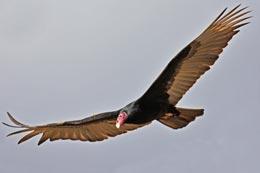 "TV" by Thomas Brown |
Notes: While their namesake turkeys often get a free ride regarding their inelegantly unfeathered heads due to their status as national icons, Turkey Vultures are often derided as among the uglier of our birds, and their habit of eating dead animals is popularly seen as somewhere between ignoble and disgusting (they almost never catch live prey). But they are hugely important ecologically, cleaning up carrion with unmatched efficiency. In India, vulture populations have crashed from the unrealized consequences of a cattle medication and the result has been water contamination and ballooning populations of disease-carrying rats and wild dogs. So respect them! FAQ: Do birds find food by smell or sight? The answer is almost universally by sight—but Turkey Vultures are the smelling-capable exception.
29. Great Horned Owl
|
|
Identifying: If you see them, which requires a little bit of persistence or a fair amount of patience, they’re very big and have prominent “ear” tufts. If you hear them, which is not hard if you spend some evenings outdoors, it’s even easier: they are the only bird that makes the classic deep hooting sound that says “owl” like nothing else (visit Cornell to hear it). None of our other owls hoot, and they look very different. (Briefly, our open country Barn Owl is white and has a very distinctive facial disc, while our woodland Western Screech Owl is much smaller and does not have such striking ear tufts or a barred belly.)
Notes: Our fiercest hunters, Great Horned Owls will eat everything from small rodents and sleepy songbirds to skunks and Barn Owls. It is, however, extremely unlikely that they will eat your dog. We don’t recommend leaving your kitten alone in an exposed but inescapable enclosure to spend the night, but short of that you should be pretty safe. With that said, they are unequivocally ferocious predators, and are heavier than any other North American owl. While some people attract Barn Owls to nesting boxes to encourage rodent control, Great Horned Owls do not use boxes, instead often taking over the open nests of large hawks, and are not very efficient rodent control anyways, given their generalist diet.
30. American Crow and Common Raven
Identifying: These two biggish, black birds are the source of much confusion, so we'll cover them together as we chafe slightly under our self-imposed 30 bird limit.
|
American Crow |
Common Raven |
|
| Perching | Smaller | Attention-grabbing big, and with big blocky beaks |
| In flight | Rounded tails, more flapping |
V-shaped tails, frequent soaring without much flapping |
| By ear | Higher-pitched cawing |
Deep, rich croaking |
| Behavior | Spend more time in large groups | More often seen alone or in pairs than crows |
Notes: Both are generally considered unwelcome at birdfeeders, due to their prodigious appetites and their tendency to branch out to eating smaller birds or eggs. But due to that generalism of appetite, it is relatively uncommon for them to focus intensively on birdfeeders. If you are in that troubled minority, we can recommend a variety of caged, weight-sensitive, or otherwise big-bird-unfriendly feeders. For the rest of us—enjoy them! Along with their smaller cousins the jays, crows and ravens make up the corvid family, one of the most successful, widespread, and intelligent of all bird families. In some cognitive tests, members of the family match up impressively compared to chimpanzees or five year old humans. In more day to day situations, we can witness their intelligence when they drop walnuts on the street to crack them open, or in their ability to recognize individual humans. You can see some of these corvid brains in action in the Nature documentary, A Murder of Crows.
Featured Product: Laws Pocket Guide to Yard Birds
Featuring art by renowned artist John Muir Laws, the Yard and Garden Birds entry in his series of Bay Area fold-out guides offers a comprehensive and excellently illustrated selection of the birds you will actually see in your yard. You just open it up and there they are at a glance: a locally curated collection uncluttered by confusing birds from across the country. See our complete review in our Book Reviews. |


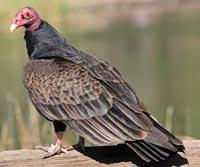 Turkey Vulture by S. Sundaram
Turkey Vulture by S. Sundaram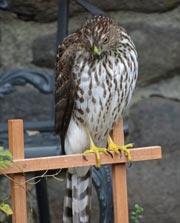 Juvenile Cooper's Hawk
Juvenile Cooper's Hawk 